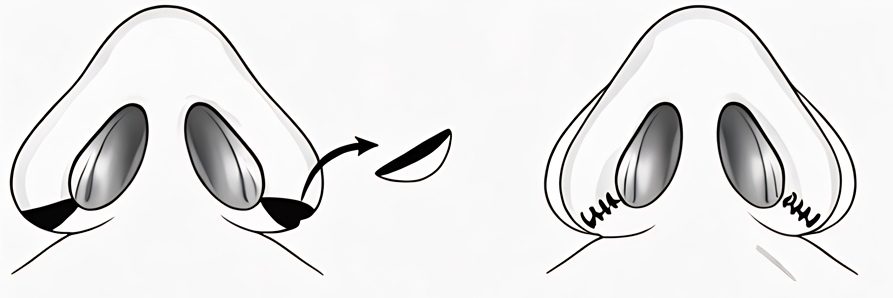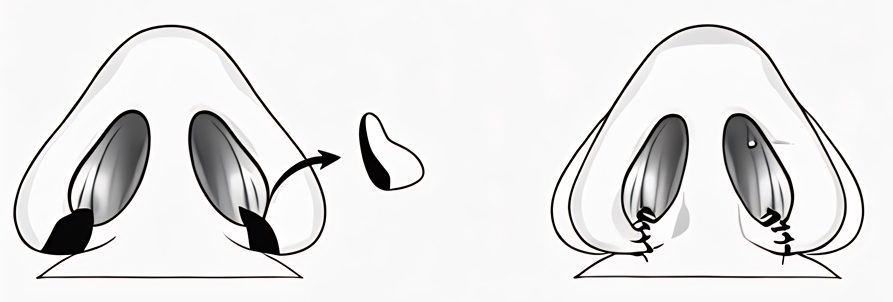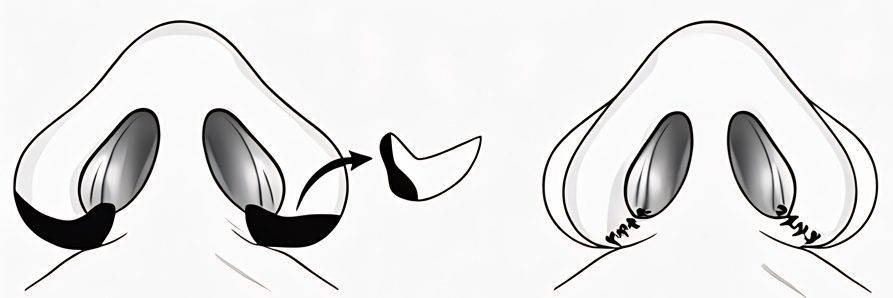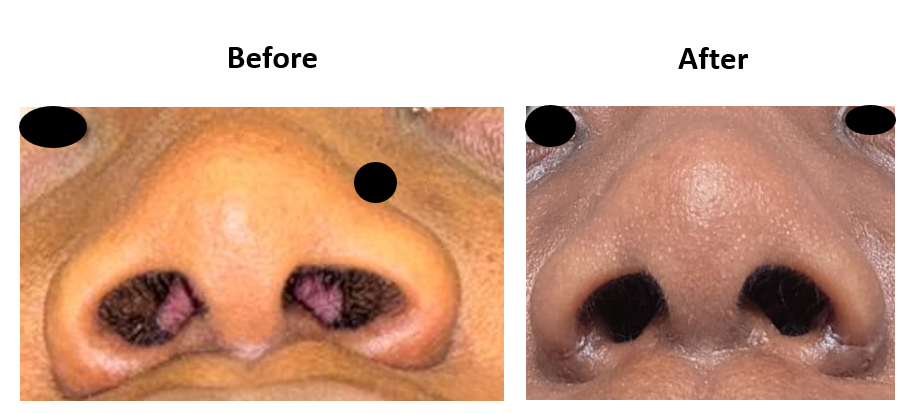Introduction
The shape and size of the nostrils—particularly the alar base (the outermost part of the nostrils)—play a crucial role in overall nasal and facial harmony. A wide or flared alar base can give the nose a broader or less refined appearance, even when the nasal bridge and tip are proportionate.
At MACS Clinic, we understand that aesthetics vary across different ethnicities. Flaring of the alae is commonly seen among individuals of Afro-Caribbean, South Asian, East Asian, and some times in Caucasian ethnicities . For many, this natural anatomical variation may prompt a desire for cosmetic refinement.
Alar base reduction is a safe, effective, and minimally invasive surgical procedure that addresses these concerns—with or without the need for a full rhinoplasty. It aims to narrow the width of the nostrils and reduce flaring to enhance facial proportion and self-confidence.
What Is Alar Base Reduction?
Alar base reduction, also known as alarplasty, involves the removal of small wedges of tissue from the sides of the nostrils (alae) to decrease their width and improve nasal aesthetics. Importantly, this procedure does not change the shape of the nasal tip or bridge—making it ideal for patients seeking targeted improvements.
This refined surgery is often part of ethnic rhinoplasty or used in isolation for patients who are otherwise satisfied with the rest of their nasal structure.
Indications for Alar Base Reduction
Alar base reduction may be recommended or requested in the following cases:
- Prominent or wide nostrils
- Excessive alar flaring (nostril flaring during expression or rest)
- Disproportion between nostril width and nasal bridge or tip
- Patient preference for subtle yet defined cosmetic enhancement
- Desire to avoid full rhinoplasty while still achieving facial balance
Anaesthesia Options at MACS Clinic
At MACS Clinic, Mr. Shailesh Vadodaria—Consultant Plastic Surgeon—typically performs alar base reduction under local anaesthesia as a walk-in/walk-out day case procedure. This allows for:
- Faster recovery
- Minimal disruption to daily activities
- Reduced cost compared to general anaesthesia
However, if alarplasty is performed as part of a comprehensive rhinoplasty, it may require intravenous sedation or general anaesthesia, depending on the extent of surgical planning.
Types of Alar Base Reduction Techniques
There is no “one-size-fits-all” approach. The technique is selected based on each patient’s nasal anatomy, degree of flare, and aesthetic goals:
- Wedge Excision (Weir Technique)
- Removes a small triangular wedge at the alar-facial groove
- Ideal for moderate flaring
- Scars are placed in the natural crease
- Nasal Sill Excision
- Removes tissue from the base/floor of the nostril
- Best for patients with wide nostrils but minimal flare
- Preserves natural curvature of the ala
- Combined Wedge and Sill Excision
- Used when both nostril width and flare are significant
- Offers more comprehensive narrowing
- Careful planning required to avoid overcorrection



The Surgical Process at MACS Clinic
- Duration: 45 to 60 minutes
- Setting: CQC registered Day Case Centre with General Anaesthetic Theatre Facility
- Anaesthesia: Local (unless combined with rhinoplasty)
- Technique: Precise measurement and symmetry checks before incision
- Closure: Fine, dissolvable sutures for minimal scarring
Risks and Potential Complications
As with any surgical procedure, alar base reduction carries certain risks. Though complications are rare, they can include:
- Scarring – Typically minimal and well-hidden, but may be visible in somr cases. Camouflage make up is advised
- Pigmentary changes – Hypo- or hyperpigmentation, more likely in patients with darker skin tones
- Asymmetry – Usually minor, but may require correction
- Hypertrophic or keloid scarring – More common in patients with a predisposition to abnormal scar formation and particularly in coloured population
- Under- or over-correction
- Nasal airway compromise
- Revision surgery
All risks are discussed thoroughly during your consultation with Mr. Vadodaria at MACS Clinic.
Aftercare and Recovery
Recovery from alar base reduction is generally smooth and uneventful:
- Mild swelling or bruising around the nose for the first 3–5 days
- Pain is minimal, managed with over-the-counter painkillers
- Sutures dissolve naturally—no need for removal
- Avoid strenuous exercise, swimming, or rubbing the nose for 1–2 weeks
- Scar maturation takes between 6 months and 18 months
- Scars mature and fade over time, becoming barely noticeable
Before and After Results


Why Choose MACS Clinic for alar base reduction?
✔ Expertise: Mr. Shailesh Vadodaria, senior consultant plastic surgeon has experience of nearly 30 years
✔ Patient-Centric Care: We endeavour to treat every patient with empathy, discretion, and professionalism.
✔ Sterile Environment: Clean, state-of-the-art facilities ensure safety and comfort.
✔Cosmetic Consideration: We minimize scarring
✔ Quick Appointments & Efficient Recovery: Minimal downtime.
✔ CQC registered clinic with outstanding rating for patients’ care
Contact MACS Clinic
- Phone: 020 7078 4378
- WhatsApp: 07792 648 726
- Email: enquiries@macsclinic.co.uk
- Website: www.macsclinic.co.uk
- BOOK a FREE Video Consultation: https://calendly.com/macsclinic/free-video-consultation?month=2025-01







